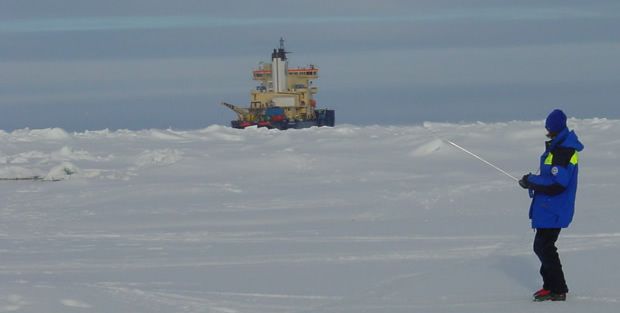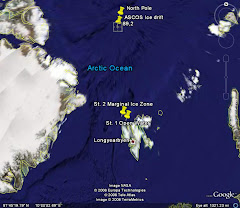By 16:00, we are at 87o 22.18N 07o 05.25.0W; air temperature -7.6C (=18.3F); winds <3 m/s; drifting south at 0.1 knots. The sun is still out!! And it is cold, very cold. These conditions of sunny, cold, little fog and high cirrus clouds has shown in the past to be ideal for nucleation events, that is, the formation of the smallest particles that the aerosol instruments can detect (<20 nm, that 10^-9m). And they've seen lots all through the night. These small particles were also seen by the instruments flown by the helicopter. On the other hand, instruments located in the very cold outside are slowing down, computer hard drives are refusing to work properly, and all 3 bubble-related devices are frozen in; the lead has now a 1cm layer of ice over the water.
Monica and Paty want to understand what happens to this organic material in the surface microlayer when it is exposed to light, especially ultraviolet radiation, for 24h per day, as it happens in spring and summer. So we prepared a wooden raft from which we hung our samples in small special bags; we covered one half of the raft with a clear film that blocks all UV radiation and the other side was exposed to natural light. We placed in open water next to the ship and tied it to the ice, just 2m away from the ship. This sounds simple; however, at -7.6C, we both had outer clothing, a life jacket, a radio and a bear guard. I radio the ship's bridge ("command center") for permission to go onto the ice and deploy; depending on what else it is going on, it is granted or we wait until it is OK; down we go. I tie a special belt around my waist which is tied to a rope held by the bear guard (either Lars-Åke Hansson, the ship's bosun or Fredrik Flink, our bear guard); I lay over the edge of the ice so I can get my hands inside the float and either hang or retrieve my baggies; I wear diving gloves; the water is very cold (-1.75C). We are done in 5 minutes. We pick up our samples, return on board Oden, radio the bridge to let them know we're back, return the radio, undress and run to the lab to process our samples.
By late evening, with temperatures staying at -7.6C, the lead is frozen with a 3cm-thick layer of ice and any liquid sampling is difficult as both seawater and chemicals freeze as soon as they are exposed to air.
Saturday, August 23, 2008
Subscribe to:
Post Comments (Atom)






No comments:
Post a Comment